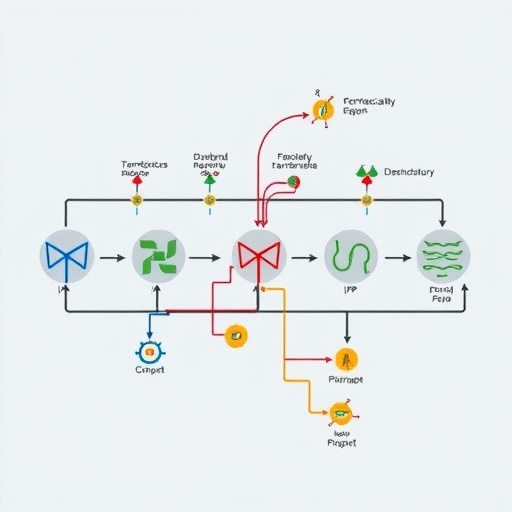In the relentless global fight against malaria, a groundbreaking study published in Nature Communications unveils an innovative, streamlined pipeline that promises to revolutionize how researchers identify and test drugs capable of halting the transmission of Plasmodium falciparum, the deadliest malaria parasite. Spearheaded by Brancucci and colleagues, this all-in-one platform integrates sophisticated in vitro screening methods with in vivo validation to accelerate the discovery of effective transmission-blocking compounds, a strategy critically needed to curb the spread of malaria and achieve elimination goals.
The challenge in malaria control extends beyond treating symptomatic infections; it demands interrupting the parasite’s life cycle at the transmission stage. Plasmodium falciparum undergoes a complex developmental journey within both human hosts and mosquito vectors. A crucial hurdle has been finding compounds that specifically target and inhibit the parasite’s sexual stages—gametocytes—thereby preventing mosquitoes from becoming carriers. Traditional screening approaches typically separate the in vitro identification and in vivo testing steps, resulting in protracted discovery pipelines that slow progress dramatically.
Brancucci et al.’s study addresses this bottleneck by presenting an integrated workflow combining cutting-edge phenotypic assays with sensitive mosquito feeding experiments. The authors optimized an assay library targeting late-stage gametocytes cultured in the laboratory, utilizing reporter parasite lines engineered for high-throughput drug screening. This approach enables precise evaluation of compound efficacy directly on the parasite forms responsible for transmission, rather than relying on surrogate markers or indirect readouts.
Beyond culturing and screening, the pipeline uniquely bridges to in vivo relevance through standardized mosquito feeding assays using human blood samples treated with candidate compounds. This method assesses the reduction in parasite infectivity to Anopheles mosquitoes—a gold standard for transmission-blocking activity. By uniting these two phases into a comprehensive experimental suite, the pipeline not only speeds drug discovery but also ensures that hits identified in vitro are rapidly vetted under physiologically meaningful conditions.
An additional innovation lies in the incorporation of molecular and imaging technologies to decipher the mode of action and toxicity profiles for candidate compounds. These multidimensional readouts augment the predictive power of the screening platform, fostering a more informed and rational approach to lead optimization. As drug resistance continues to undermine traditional antimalarials, the ability to discern mechanisms preventing transmission is invaluable for developing novel classes of agents tailored to distinct parasite vulnerabilities.
The study further emphasizes scalability and reproducibility, essential for global collaborations and wide adoption in endemic regions. By providing standardized protocols and reagents, the research empowers other laboratories to engage in transmission-blocking drug discovery with robust and comparable results. This democratization of methodology could catalyze a surge in candidate molecules entering preclinical pipelines, accelerating the timeline from bench to bedside.
Given the biological complexity of P. falciparum gametocytes, which are notoriously refractory to many drugs, the described pipeline is a major step toward overcoming existing scientific impediments. Researchers can now systematically evaluate hundreds of compounds with unprecedented resolution and throughput, an advance that could unveil breakthrough chemotypes previously overlooked due to suboptimal assays.
Importantly, the integration of in vivo mosquito infectivity assays within the discovery pipeline acknowledges the indispensable role of vector biology in malaria pathogenesis. This holistic perspective ensures that compounds effective in eliminating gametocytes in a dish also translate to blocking transmission in real-world biological contexts, a critical validation step often omitted in early drug development.
Brancucci and colleagues illustrate their platform’s efficacy by screening a curated chemical library enriched for molecules with potential gametocytocidal activity. Their systematic analysis highlights several promising candidates exhibiting potent transmission-blocking properties, which further underwent mechanistic studies revealing novel parasite targets. This approach sets a blueprint for subsequent studies that combine chemical biology with vector-parasite interactions.
The implications of this all-in-one pipeline extend beyond P. falciparum, potentially adaptable to other mosquito-borne parasites with complex life cycles, including Plasmodium vivax and emerging arboviruses. By establishing a scalable, modular testing framework, the authors open avenues for cross-pathogen comparisons and synergistic interventions aimed at curbing vector-mediated diseases more broadly.
One of the compelling aspects of this study is the meticulous attention to translational potential. Unlike many preclinical models limited to proof-of-concept stages, this pipeline is designed with the drug development pipeline in mind, facilitating early identification of safety and efficacy parameters under conditions mimicking natural transmission. This reduces attrition in costly clinical phases and offers hope for faster delivery of novel therapeutics.
Furthermore, the incorporation of advanced statistical and machine learning tools for data analysis enhances the precision and predictive accuracy of screening outcomes. Deep phenotyping combined with computational modeling enables the prioritization of compounds with the highest likelihood of success, refining the drug candidate selection process beyond traditional heuristic approaches.
Beyond its technical merits, this study carries significant public health implications. The capacity to interrupt malaria transmission by targeting the sexual stages could revolutionize control programs, especially in areas struggling with emerging resistance to front-line therapies. Drugs discovered and validated through this platform could complement current interventions such as insecticide-treated nets and vaccines, forming a multifaceted arsenal against malaria resurgence.
In conclusion, the innovative all-in-one pipeline developed by Brancucci et al. represents a paradigm shift in malaria drug discovery. By seamlessly linking detailed laboratory investigations with ecologically relevant infectivity assessments, the methodology propels the field toward a new era where transmission-blocking strategies can be discovered, optimized, and deployed with unprecedented speed and confidence. This advancement stands to make a lasting impact in the global effort to eradicate one of humanity’s most persistent and devastating scourges.
Subject of Research: Transmission-blocking drug discovery and validation for Plasmodium falciparum malaria
Article Title: An all-in-one pipeline for the in vitro discovery and in vivo testing of Plasmodium falciparum malaria transmission blocking drugs
Article References:
Brancucci, N.M.B., Gumpp, C., van Gemert, G.J., et al. An all-in-one pipeline for the in vitro discovery and in vivo testing of Plasmodium falciparum malaria transmission blocking drugs. Nat Commun 16, 6884 (2025). https://doi.org/10.1038/s41467-025-62014-3
Image Credits: AI Generated




